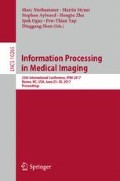Abstract
Many methods have been developed to spatially normalize a population of brain images for estimating a mean image as a population- average atlas. However, methods for deriving a network atlas from a set of brain networks sitting on a complex manifold are still absent. Learning how to average brain networks across subjects constitutes a key step in creating a reliable mean representation of a population of brain networks, which can be used to spot abnormal deviations from the healthy network atlas. In this work, we propose a novel network atlas estimation framework, which guarantees that the produced network atlas is clean (for tuning down noisy measurements) and well-centered (for being optimally close to all subjects and representing the individual traits of each subject in the population). Specifically, for a population of brain networks, we first build a tensor, where each of its frontal-views (i.e., frontal matrices) represents a connectivity network matrix of a single subject in the population. Then, we use tensor robust principal component analysis for jointly denoising all subjects’ networks through cleaving a sparse noisy network population tensor from a clean low-rank network tensor. Second, we build a graph where each node represents a frontal-view of the unfolded clean tensor (network), to leverage the local manifold structure of these networks when fusing them. Specifically, we progressively shrink the graph of networks towards the centered mean network atlas through non-linear diffusion along the local neighbors of each of its nodes. Our evaluation on the developing functional and morphological brain networks at 1, 3, 6, 9 and 12 months of age has showed a better centeredness of our network atlases, in comparison with the baseline network fusion method. Further cleaning of the population of networks produces even more centered atlases, especially for the noisy functional connectivity networks.
Access this chapter
Tax calculation will be finalised at checkout
Purchases are for personal use only
References
Brown, C., Hamarneh, G.: Machine learning on human connectome data from MRI arXiv:1611.08699v1 (2016)
Miller, K., Alfaro-Almagro, F., Bangerter, N., Thomas, D., et al.: Multimodal population brain imaging in the UK Biobank prospective epidemiological study. Nat. Neurosci. 19, 1523–1536 (2016)
Fallik, D.: The human connectome project turns to mapping brain development, from birth through early childhood. Neurol. Today 16, 7–9 (2016)
Glasser, M., Coalson, T., Robinson, E., Hacker, C.D., et al.: A multi-modal parcellation of human cerebral cortex. Nature 536, 171–178 (2016)
Wassermann, D., Mazauric, D., Gallardo-Diez, G., Deriche, R.: Extracting the core structural connectivity network: guaranteeing network connectedness through a graph-theoretical approach. In: Ourselin, S., Joskowicz, L., Sabuncu, M.R., Unal, G., Wells, W. (eds.) MICCAI 2016. LNCS, vol. 9900, pp. 89–96. Springer, Cham (2016). doi:10.1007/978-3-319-46720-7_11
Chen, X., Zhang, H., Shen, D.: Ensemble hierarchical high-order functional connectivity networks for MCI classification. In: Ourselin, S., Joskowicz, L., Sabuncu, M.R., Unal, G., Wells, W. (eds.) MICCAI 2016. LNCS, vol. 9901, pp. 18–25. Springer, Cham (2016). doi:10.1007/978-3-319-46723-8_3
Wu, G., Jia, H., Wang, Q., Shen, D.: SharpMean: groupwise registration guided by sharp mean image and tree-based registration. NeuroImage 56, 1968–1981 (2011)
Lu, C., Feng, J., Chen, Y., Liu, W., et al.: Tensor robust principal component analysis: exact recovery of corrupted low-rank tensors via convex optimization. In: CVPR, pp. 5249–5257 (2016)
Wang, B., Mezlini, A., Demir, F., Fiume, M., et al.: Similarity network fusion for aggregating data types on a genomic scale. Nat. Methods 11, 333–337 (2014)
Ying, S., Wu, G., Wang, Q., Shen, D.: Hierarchical unbiased graph shrinkage (HUGS): a novel groupwise registration for large data set. Neuroimage 1, 626–638 (2014)
Frey, B., Dueck, D.: Clustering by passing messages between data points. Science 315, 972–976 (2007)
Li, G., Wang, L., Shi, F., et al.: Simultaneous and consistent labeling of longitudinal dynamic developing cortical surfaces in infants. Med. Image Anal. 18, 1274–1289 (2014)
Wang, L., Shi, F., Lin, W., Gilmore, J.H., Shen, D.: Automatic segmentation of neonatal images using convex optimization and coupled level sets. NeuroImage 58(3), 805–817 (2011)
Li, G., Nie, J., Wang, L., Shi, F., Gilmore, J.H., Lin, W., Shen, D.: NeuroImage 90, 266–279 (2014)
Acknowledgments
This work is also supported in part by National Institutes of Health grants (MH100217, MH108914 and MH107815) a grant from NIH (1U01MH110274) and UNC/UMN Baby Connectome Project Consortium.
Author information
Authors and Affiliations
Corresponding author
Editor information
Editors and Affiliations
Rights and permissions
Copyright information
© 2017 Springer International Publishing AG
About this paper
Cite this paper
Rekik, I., Li, G., Lin, W., Shen, D. (2017). Estimation of Brain Network Atlases Using Diffusive-Shrinking Graphs: Application to Developing Brains. In: Niethammer, M., et al. Information Processing in Medical Imaging. IPMI 2017. Lecture Notes in Computer Science(), vol 10265. Springer, Cham. https://doi.org/10.1007/978-3-319-59050-9_31
Download citation
DOI: https://doi.org/10.1007/978-3-319-59050-9_31
Published:
Publisher Name: Springer, Cham
Print ISBN: 978-3-319-59049-3
Online ISBN: 978-3-319-59050-9
eBook Packages: Computer ScienceComputer Science (R0)

